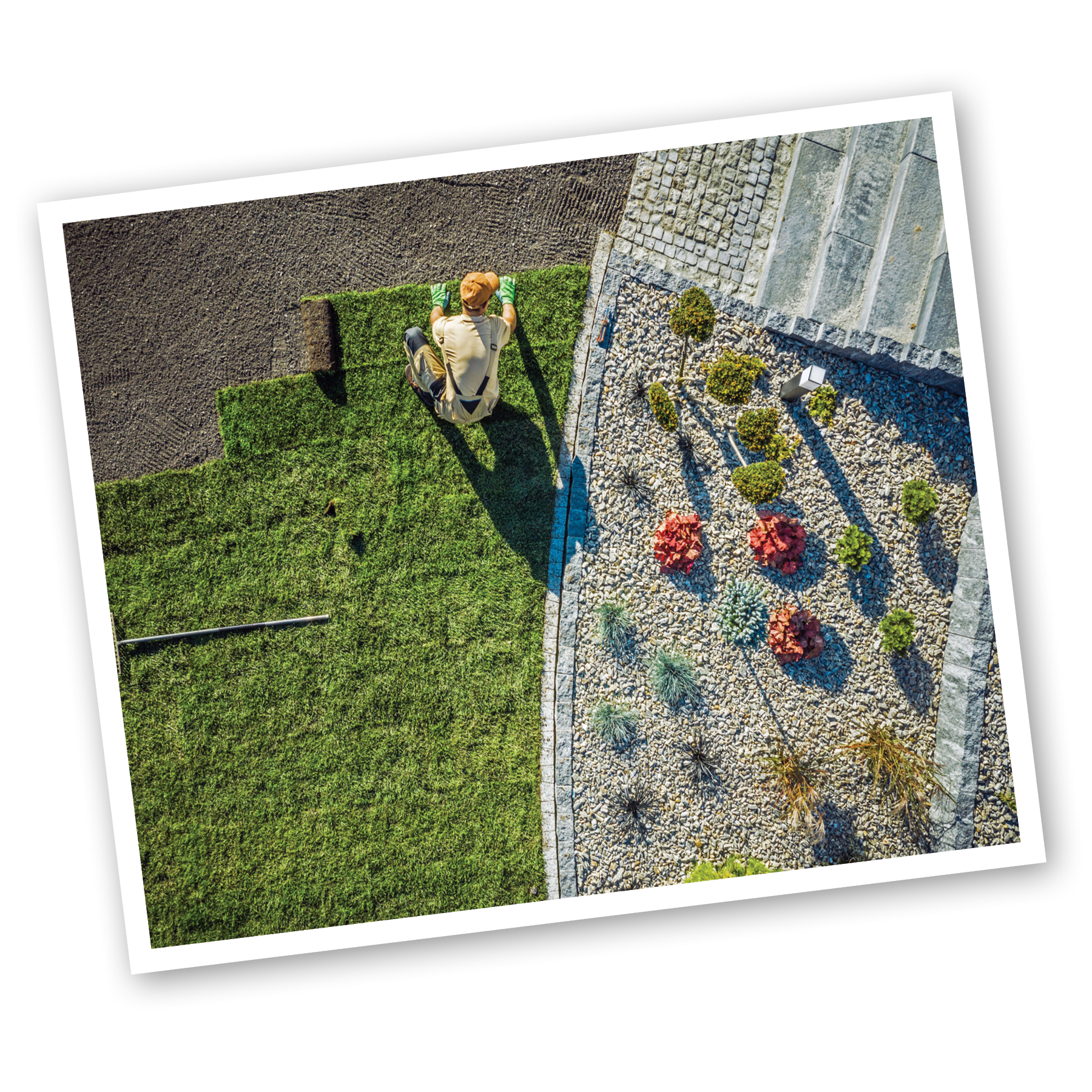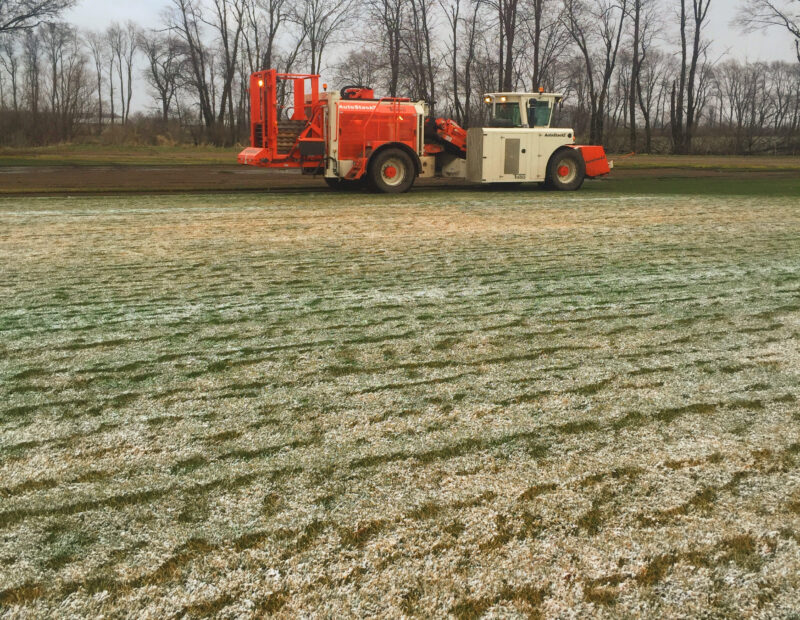
Sod laying is not rocket science, but unless you do it fairly often, you are likely to miss some important points that really affect the outcome of the job. If you consider the following points before you start laying sod, you will find the process easier and end up with a nicer, more professional lawn.
For more on Red Hen’s Sales Terms, Conditions & Guarantee, CLICK HERE
Sod is ideal for full sun and light amounts of shade. As a rule, bluegrass needs a minimum of 4 hours of sun per day. Air movement also has a big effect. Trees that have high branches that let the air move are better sites for bluegrass, than a maple tree surrounded by a solid board privacy fence.
Adding topsoil is not essential for sod but it will provide some benefits. What topsoil does is increases a soil’s water and nutrient holding capacity, so if you do add it, the intervals between watering and fertilizing will be longer. If you do want to add topsoil, 2 inches will provide good benefits if you mix it into the existing soil. If you cannot have the topsoil mixed into the existing soil, then do not apply it! A thin layer of topsoil prevents grass plants from rooting deeply.
Sod is sold by the square foot, so calculating how much you need is as simple or hard as measuring your site. Be sure and order enough to account for trimming because we cannot deliver you another 500 sq feet for the same price we just delivered you 5000 sq feet. However, if you do under measure, you can pick sod up at our farm for the same price as we just delivered.
Most builders provide homeowners with a rough grade that is done with a bulldozer that leaves the soil fairly level but usually compacted. Having a landscaper tractor rake a lawn to remove compaction and level the soil more is money very well spent. Many landscapers work with builders and are happy to perform this service even if you will lay the sod yourself. A rototiller also does a good job of loosening the soil but you still need to level it. If you are adding topsoil, while it may cost a bit more, it is worth it to have the landscaper loosen the soil first, then apply the topsoil, and then have the landscaper return to mix the 2 soils together.
Sod is a living thing, and the shorter the time it stays rolled up, the better. It can last 3 or 4 days in the spring rolled up, but needs to be unrolled the same day you get it in summer. Weather can be unpredictable, and once you confirm your order and we harvest your sod, it is yours. Rain delays can stress both you and your sod, something else to take into account as you decide to lay sod yourself or have it done.
You need shovels and rakes to prepare the soil. Sod can be cut with a variety of tools, such as an old steak knife. Have plenty of hoses and sprinklers present if you don’t have a sprinkler system.
Red Hen Sod is guaranteed to be in good growing condition at the time of sale; after that, it is your responsibility. If the sod is not watered properly, it will not grow. Call us immediately at the time of sale if the sod is anything but healthy, and we will give the matter our prompt attention. We’re also just a phone call away for technical support for years to come. If questions or concerns arise, call us sooner rather than later so we have the best opportunity to help you course-correct.
Before You Lay Sod

Sod is ideal for full sun and light amounts of shade. As a rule, bluegrass needs a minimum of 4 hours of sun per day. Air movement also has a big effect. Trees that have high branches that let the air move are better sites for bluegrass, than a maple tree surrounded by a solid board privacy fence.
Adding topsoil is not essential for sod but it will provide some benefits. What topsoil does is increases a soil’s water and nutrient holding capacity, so if you do add it, the intervals between watering and fertilizing will be longer. If you do want to add topsoil, 2 inches will provide good benefits if you mix it into the existing soil. If you cannot have the topsoil mixed into the existing soil, then do not apply it! A thin layer of topsoil prevents grass plants from rooting deeply.
Sod is sold by the square foot, so calculating how much you need is as simple or hard as measuring your site. Be sure and order enough to account for trimming because we cannot deliver you another 500 sq feet for the same price we just delivered you 5000 sq feet. However, if you do under measure, you can pick sod up at our farm for the same price as we just delivered.
Most builders provide homeowners with a rough grade that is done with a bulldozer that leaves the soil fairly level but usually compacted. Having a landscaper tractor rake a lawn to remove compaction and level the soil more is money very well spent. Many landscapers work with builders and are happy to perform this service even if you will lay the sod yourself. A rototiller also does a good job of loosening the soil but you still need to level it. If you are adding topsoil, while it may cost a bit more, it is worth it to have the landscaper loosen the soil first, then apply the topsoil, and then have the landscaper return to mix the 2 soils together.
Sod is a living thing, and the shorter the time it stays rolled up, the better. It can last 3 or 4 days in the spring rolled up, but needs to be unrolled the same day you get it in summer. Weather can be unpredictable, and once you confirm your order and we harvest your sod, it is yours. Rain delays can stress both you and your sod, something else to take into account as you decide to lay sod yourself or have it done.
You need shovels and rakes to prepare the soil. Sod can be cut with a variety of tools, such as an old steak knife. Have plenty of hoses and sprinklers present if you don’t have a sprinkler system.
Red Hen Sod is guaranteed to be in good growing condition at the time of sale; after that, it is your responsibility. If the sod is not watered properly, it will not grow. Call us immediately at the time of sale if the sod is anything but healthy, and we will give the matter our prompt attention. Don’t call us 2or 3 days later and tell us our sod looked bad when we delivered it.
For more on Red Hen’s Sales Terms, Conditions & Guarantee, CLICK HERE
Sod laying is not rocket science, but unless you do it fairly often, you are likely to miss some important points that really affect the outcome of the job. If you consider the following points before you start laying sod, you will find the process easier and end up with a nicer, more professional lawn.
Before You Lay Sod

Updated 12/5/25
Red Hen Turf Farm’s
2025 Sod Harvesting Season
has OFFICIALLY ENDED
as of 12/5/25
due to SNOW / Precipitation and Unfavorable Field Conditions.
We had hoped to keep going until 12/19/25, but Mother Nature did not get that Memo, apparently :)
* * *
If you’re reading this in early 2026 and wonder when we might start back up again, a quick call will confirm our
SOD HARVEST FORECAST
– 574-232-6811 –
is the number to call.